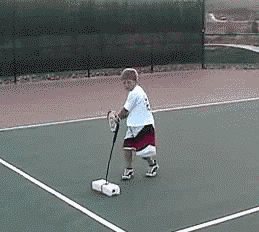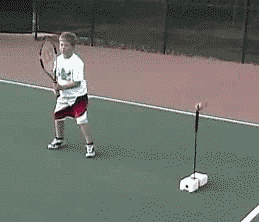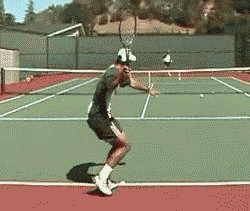|
TennisOne Lessons
Using Targets, Walls, and Ball Machines By David Smith Using targets on the tennis court during drills has been practiced for decades. Certainly, the use of targets helps provide feedback to the player on the outcome of a shot. Unfortunately, the use of targets doesn't provide player feedback on the quality of the stroke. And understanding this difference, between the feedbacks of stroke quality versus target quality, is important to both the student and the teacher. Understanding the Ego In any lesson, especially group lesson, the aspect of hitting a target is a supreme ego-gratifying experience. In this respect, it can be easily seen why targets are such great motivators in terms of focus during practice. However, players who are interested in becoming better through better form or technique must understand that hitting the target is NOT the primary concern.
Training Beginners For those wanting to know how to train your young children in becoming the next multi-millionaire tennis player, (or simply wanting to have your children reach their tennis potential!), get rid of the balls and the targets! Every player, young or old, when presented with hitting a tennis ball towards a target will usually resort to the most familiar stroke pattern, grip, or swing they feel will help them hit the target. Think about it. If you didn't know any better, would you try to hit a target with an unfamiliar grip or swing pattern? Remember that familiar or comfortable strokes lead to confidence. Unfortunately, if the goal is to develop more refined or sophisticated strokes or grips, players who find these newly learned strokes and grips uncomfortable will seldom feel confident in using them to hit a target. When working with very young children, I use only a "Practice Hit", a device that has a foam ball attached to a fiberglass shaft, that oscillates forward and backward, (like a metronome) when hit. (Information about the Practice Hit can be found at www.practicehit.com .) This device provides the challenge of simply hitting the ball as it comes towards the student - developing the necessary aspect of timing when swinging at a ball coming towards you. However, the device provides no concept of where the ball might go. And this is exactly what I want. Little kids, when pressed into a hitting environment, will lose consciousness of what they are trying to do in terms of strokes and grips, especially when trying to hit a ball towards a specific target. The fact is, you don't even need to have cones or other targets on the court. Simply having a net and the other side of the court is enough 'target' for players to abandon what they are trying to do in favor of simply hitting the ball the only way they know how! When my daughter was three, I used predominately the Practice Hit and, only occasionally, did I toss balls to her to swing at. (Not on a tennis court, only on our driveway.) I honestly didn't think she had much coordination since she seldom hit the ball when tossed to her. But, because we focused more on the success of using the practice hit, she had no trouble developing the swing pattern I wanted her to have. We worked at this only about 10 times over the course of two years. When she was five and a half, we went to the courts for the first time. I first dropped balls to her forehand and backhand side. While her first few swings missed the balls completely, her strokes were nearly perfect each time. Without me having to say much at all, she used these same, desired strokes, and simply 'found' the ball by trial and error. She did not resort back to a different swing pattern because the swing pattern we had worked on, even in such a short period of time, was her most familiar pattern. Within a few minutes, my five-year old, was hitting topspin forehands and backhands over the net with form that is associated with skilled play.
Now Come the Targets Once a player develops a desired swing pattern with the correct grip, then targets become a critical part of their improvement. Instead of changing the swing pattern or grip to the more familiar to attempt to hit the target, the player adjusts the timing or the feet or the swing path, to meet the ball and aim better. This is seldom possible when players are too familiar with inferior or detrimental strokes. Such players might actually be able to do it in practice, but seldom in competition. Competition reveals, even more than targets, whether a player has mastered a grip or stroke. Because competition now involves keeping score, (as opposed to the simple immediacy of hitting or not hitting a target), players will be even more likely to revert to the most familiar strokes and the false sense of confidence such strokes or techniques provides. Ball Machines and Hitting Walls Like targets, ball machines and hitting walls can either contribute to a player's development or actually hinder it. If a player adjusts to either a ball coming from a ball machine or a ball coming off a wall, by using familiar strokes, grips or techniques, (which may be ineffective or non-progressive), the player will only develop a greater affinity for such inferior shots. I usually refer to this as 'a player getting better at being bad."
Players must be clear on what shots they are practicing and becoming familiar with. Nothing is more frustrating for me to watch, than a player hitting terrible strokes against a wall or off a ball machine! Especially on a wall, the player can actually hit targets on a wall fairly consistently using inferior–but familiar strokes. However, the wall does not provide the feedback as to whether the shot would have landed in or sailed long. How many racquetball shots are effective in tennis? Yet, I see many players hitting on a wall using their wrist, similar to that which we often see racquetball players use. Walls and ball machines can be very helpful…when the player knows and can control what they are working on. So often, players have the ball machine set too fast and end up developing even worse habits because they don't have time to establish the desired stroke pattern they want to work on. So they end up slapping at the ball just so they don't miss it. Players often hit too hard on a wall, or stand too close. It isn't as important to me that a player hits the ball on one bounce when hitting against the wall; it is important to me that they move their feet and stroke the ball using the correct swing pattern and grip. Then, working on hitting targets on the wall or across the net will pay off! Members of TennisONE have a huge library of skilled technique at their disposal they can study and work on emulating. Once they have a clear 'blueprint' of how to hit the ball, they can take to the courts and employ targets, walls, and ball machines to become whatever level player they want to become! Your comments are welcome. Let us know what you think about Dave Smith's article by emailing us here at TennisOne .
|





 Your comments are welcome. Let us know what you think about this article by
Your comments are welcome. Let us know what you think about this article by